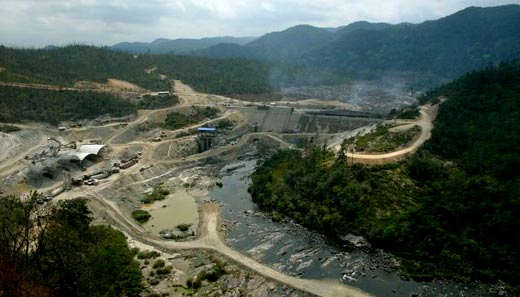
|
| Whether you like it or not, the Chalillo Dam is now a fact of life in Belize. The construction of the controversial dam was completed in September 2005. The commissioning ceremony was held on November 15, 2005. Just the facts, the project required 200,000 cubic yards of concrete in order to retain 120 million cubic metres of water. It was constructed by Chinese workers employed by Fortis, Inc. of Canada, BECOL(Belize Electric Company Limited, a subsidiary of Forits, Inc.) and BEL( Belize Electric Limited, a subsidiary of Forits, Inc.), in concert with the Canadian International Development Agency (CIDA) and SinoHydro, the biggest dam builder in China. The dam itself is 30 meters high (about 150 feet at it's highest point) and will produce a maximum of 5 Megawatts fixed energy, both from Chalillo and by adding storage to the Mollejon Hydroelectric Plant where the water will be stored and converted to energy. It may provide up to 80 Gigawatt hours of energy, mostly during times that other sources of energy are far cheaper. As mentioned, the Chalillo Dam will store water for the Mollejon Hydroelectric Plant, effectively doubling that plant's capacity and anticipated to greatly reducing Belize's reliance on costly fuel based energy. In the beginning construction of the project was estimated to cost US$30 million. Though Fortis/BECOL have never released the actual figures, the numbers recently presented at the November commissioning ceremony were in the neighbourhood of US$100 million, over three times the initial estimates. According to Ari Hershowitz who coordinates the www.StopFortis.org website on behalf of the International Coalition to Save the Macal River, " The number of species displaced is difficult to calculate. The Natural History Museum report lists more than 50 mammal species in the Macal River Valley, 185 bird species as well as large numbers of amphibians and reptiles. It is clear that the dam has displaced Tapir, the Scarlet Macaw, and Jaguar, as well as many other endangered species." Mr. Horowitz in correspondence with BELIZEmagazine.com continued,
Ms. Sharon Matola, an independent and determined biologist and former circus performer who is the director and founder of the Belize Zoo, opinions about the dam is straightforward. As she writes in a recent email, "Too bad that cat(regarding the Jaguar photo posted on the www.StopFortis.org website) is dead now, but at least we have higher electricity prices, a decrease in the quality of the Macal River, and a future to look forward to in Belize minus the Scarlet Macaw. What a trade-off. Glad I new that area when it was so special." |
reports generated by trusted studies, that element of persuasion provided by CEO Marshall to his shareholders, would not, could not, have occurred." BELIZEmagazine.com was contacted by The Belize Audubon Society (BAS) in order to be allowed to respond to Ms. Matola's comments. Ms. Tanya Williams Thompson, Advocacy Manager for the Belize Audubon Society wrote, " The Belize Audubon Society (BAS) has a long tradition of leadership on environmental issues, and has strived for the past 36 years to achieve its mission to “create a balance between people and the environment, and an improved quality of life for all”. This task is often difficult in Belize where there is an urgent need for economic development and yet our natural assets are universally treasured. In the case of the Macal River Upstream Storage Facility (Chalillo), Belize is using a renewable energy source ‘hydro-power’ reducing the use of fossil fuel and associated air pollution problems." "BAS conditionally approved the Environmental Impact Assessment (EIA) for the Chalillo Dam in 2001. The Society’s conditional acceptance of the EIA was based on BECOL’s adherence to the Environmental Compliance Plan (ECP) developed by the Department of the Environment and the members of NEAC. The following conditions were to be strictly adhered to: performance bond after construction, emergency management mechanism, complete hydrological monitoring, monitoring of biodiversity and continuous public information sessions. To the best of our knowledge, these conditions have been implemented and the Dept. of the Environment will continue to monitor the Dam for the next two years." |
||||||
"Furthermore, having been involved in the Chalillo debate since 1998, the Advocacy team, Board of Directors and Executive Director of BAS were able to evaluate the EIA objectively. However we also requested assistance from other experts including a local economist, a local social scientist, the Cayo-based organization, Friends for Conservation and Development and the international conservation organization the World Conservation Union (IUCN). " "Many of us voiced our concerns about the possible impacts on wildlife in the Chalillo area. But what we found during the process of reviewing the EIA is that there had been a lot of misinformation circulating regarding these impacts, not only in Belize but also throughout the world. The wildlife studies that were conducted by Britain’s Natural History Museum actually found only four nests of the Scarlet Macaw in the area that would be inundated by water. Although CITES lists the Scarlet Macaw as “threatened throughout its range” (not “endangered”, which is a more serious category), the population of Scarlet Macaws in Belize is stable. According to the EIA, the main impact on wildlife will not be death or extinction, but displacement and changes in ecology. There are several other locations within the country that have the same forest type as that found in the Chalillo area; the same forest type favored by the Scarlet Macaw." "BAS’ position is that indeed there are no ecosystems or wildlife species in the area to be inundated that are not represented elsewhere in the country. BAS is satisfied that with more than 40% of Belize’s land under some form of environmental protection, we are more than able to maintain healthy biodiversity of all of the species that populate the land and water, whether or not the project was approved." "It is BAS’ position that the most serious environmental
problem facing Belize is not a single development project like
Chalillo but poverty. Poor people will often do whatever it
takes to make a living without much regard for long-term environmental
quality, and this is hardly surprising. The real environmental
challenge we therefore face in Belize is to bring prosperity
to the people of this nation so that they have more choices
in how they sustain themselves, and are more able to pay for
environmental conservation programs." Stan Marshall, the President of Fortis, Inc. at the commissioning
ceremony openly admitted, "We regret not having reached
this milestone earlier. The burden of today's high oil prices
weighs heavy on us." Built with all the pomp and pageantry of the commissioning ceremony, Lyn Young, the CEO of BEL, openly had very little good news to deliver to the people of Belize. As Lyn Young put it, "My regret is that this didn't happen two years ago because as I stand here now, we are talking about asking the government for another rate increase. I know its not good news but that's the truth. I think its going to be at least 10% and what I hope is that in two or three years we'll see things start to come down back again. But I think in the short term, we are looking at high energy prices. And its not only Belize of course, its all over the world. We are looking at high energy prices for at least another two to three years." Even with the projected millions of dollars to be saved by The Chalillo Dam as Belize shifts from it's dependence upon Mexico for it's energy to that produced by the Chalillo dam, BEL has already made it's rate increase request to the Government of Belize and requested a 10% price increase to be levied against the people of Belize. The expected increases have been approved as of this writing. According to their website BEL is 67% owned by Fortis Inc. and "meets the country’s peak demand of almost 61 megawatts (MW) from multiple sources. These sources include electricity purchases from Belize Electric Company Ltd. (BECOL), which operates the Mollejon Hydroelectric facility in Western Belize; from Comisión Federal de Electricidad (CFE), the Mexican state owned electricity company; and from BEL's gas turbine unit and diesel fired generation. All major load centers are connected to the country’s national electricity system, which in turn is connected to the Mexican electricity grid, allowing BEL to optimize its power supply options." |
|||||
According to the StopFortis.org website, an opposition coalition
of environmental organizations from around the globe (http://www.stopfortis.org/coalition.html), |
 |
The Government and people of Belize will be paying the Canadian Fortis group in US dollars for energy produced by the Belize's Macal River, a precious Belizean natural resource. For the harsh reality of the deal, the Government of Belize in February 2001 signed a deal with Fortis that gives the energy giant exclusive rights over the energy produced by The Chalillo Dam for the next 50 years. And so during the period when oil prices we continue to increase drastically due to oil reserves dimensioning globally, Belize is locked into a deal that the next generation of Belizeans will be forced to pay for. For Fortis, well the deal was all about the return. Although Fortis President Stan Marshall said he has a personal connection to Belize by way of a vacation home he owns in Placencia, it was still a bottom line issue for the company. In Mr. Marshall's own words, "We need to get returns because we've invested a great deal of money here and like anybody that's invested money, we have to get a return on that. But the price of electricity is fixed. This plant will be here for a hundred years. I guarantee you that five years from now people will be marvelling at how cheap power is from this plant. Fifty years from now they'll say the people who built this dam didn't get much benefit from it, its all the people of Belize. So what we'll get is just a return of the money we've invested, the rate of return, that's all." All said, Fortis, Inc. will be a paid a minimum return of 15% on their estimated investment of US$100,000,000.00. In the end, we all need to wait and hear what the people of Belize will in fact be saying about The Chalillo Dam in five years and in fifty years. Right now, one month after the commissioning of the controversial dam one thing is absolutely crystal clear as to what the people of Belize are saying, "our electric bills are going up, again". |
Top
photo courtesy of Calton
Ward Jr.. Please also take a look at these website www.linc.us www.internationaljournalism.com/macalphoto1.html |
| Photos of the Chalillo Dam site courtesy of Sharon Matola, The Belize Zoo |


